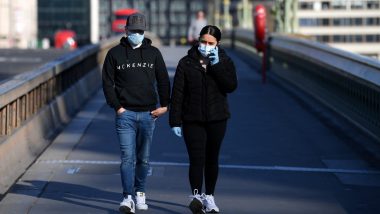London, September 26: The UK government's COVID-19 watchlist has been expanded from 58 to 92, including all boroughs of London, as the rate of infection continues to rise across Britain.
London Mayor Sadiq Khan said he has spoken to UK Prime Minister Boris Johnson and urged him to impose a ban on the UK capital's estimated 9 million residents mixing between households as he criticised the government over a lack of adequate coronavirus testing facilities. Also Read | Pakistan Cabinet Failed to Take Up Cases of Violence on Journalist in First 62 Meetings: Report.
"One of the things that I said to the Prime Minister is: I think we should be following what's happening around the country and stopping social mixing of households, and I say that with a heavy heart," Khan told 'The Guardian'.
"I'm really angry. It's another example of lessons not being learned. You can explain the delay, incompetence in March. There's no excuse now," he said, in reference to a reported drop in the number of coronavirus tests carried out in London in recent weeks. Also Read | Donald Trump Calls Black Lives Matter Movement ‘Extreme Socialist’ Organisation.
After four areas were removed, there are now 92 places on the government's watchlist for tougher localised action amid a spike in cases. According to estimates, this means more than a quarter of the UK population is set to be under coronavirus lockdown rules as new measures come in force this weekend.
The total number of people across the UK living under stricter rules will stand at 17 million from this weekend. From Saturday in England, households in Leeds, Wigan, Stockport and Blackpool will be banned from mixing in each other's homes or gardens. In Wales, Llanelli will be subject to new rules, with Cardiff and Swansea following from Sunday. Meeting between households indoors has already been banned in Scotland.
In England, the "rule of six" and a 10pm closing time for pubs and restaurants applies nationally. Besides, extra restrictions have been imposed in several other areas including large parts of north-east and north-west England, West Yorkshire and the Midlands where the infection rate is higher.
UK Health Secretary Matt Hancock said he recognised "the burden and impact these additional measures have on our daily lives but we must act collectively and quickly to bring down infections". The restrictions come in as the R number -- rate of virus transmission from infected person -- continues to creep upwards.
The number needs to remain below 1.0 to keep the pandemic under control but it is now between 1.2 and 1.5, which means that on average every 10 people infected will infect between 12 and 15 others. Meanwhile, the daily number of confirmed COVID-19 cases in the UK has reached a record high of 6,874.
Around 32 universities in the UK have also confirmed coronavirus cases, with students being asked to follow strict quarantine rules. Hundreds at Manchester University have been told to self-isolate after 127 positive coronavirus tests on the campus.
It comes after students in Scotland were told to avoid pubs after outbreaks forced hundreds into isolation at universities including Glasgow and Edinburgh Napier.
(The above story is verified and authored by Press Trust of India (PTI) staff. PTI, India’s premier news agency, employs more than 400 journalists and 500 stringers to cover almost every district and small town in India.. The views appearing in the above post do not reflect the opinions of LatestLY)













 Quickly
Quickly













